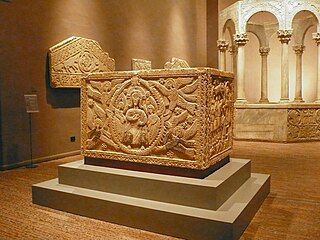
Ratchis was the Duke of Friuli (739–744) and then King of the Lombards (744–749).

Agilulf, called the Thuringian and nicknamed Ago, was a duke of Turin and king of the Lombards from 591 until his death.
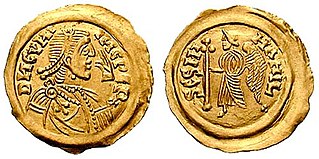
Cunipert was king of the Lombards from 688 to 700. He succeeded his father Perctarit, though he was associated with the throne from 680.
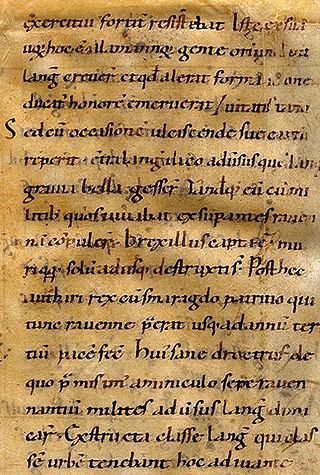
The History of the Lombards or the History of the Langobards is the chief work by Paul the Deacon, written in the late 8th century. This incomplete history in six books was written after 787 and at any rate no later than 796, maybe at Montecassino.
The Rule of the Dukes was an interregnum in the Lombard Kingdom of Italy (574/5–584/5) during which Italy was ruled by the Lombard dukes of the old Roman provinces and urban centres. The interregnum is said to have lasted a decade according to Paul the Deacon, but all other sources—the Fredegarii Chronicon, the Origo Gentis Langobardorum, the Chronicon Gothanum, and the Copenhagen continuator of Prosper Tiro—accord it twelve years. Here is how Paul describes the dukes' rule:
After his death the Langobards had no king for ten years but were under dukes, and each one of the dukes held possession of his own city, Zaban of Ticinum, Wallari of Bergamus, Alichis of Brexia, Euin of Tridentum, Gisulf of Forum Julii. But there were thirty other dukes besides these in their own cities. In these days many of the noble Romans were killed from love of gain, and the remainder were divided among their "guests" and made tributaries, that they should pay the third part of their products to the Langobards. By these dukes of the Langobards in the seventh year from the coming of Alboin and of his whole people, the churches were despoiled, the priests killed, the cities overthrown, the people who had grown up like crops annihilated, and besides those regions which Alboin had taken, the greater part of Italy was seized and subjugated by the Langobards.
Erchempert was a Benedictine monk of the Abbey of Monte Cassino in Italy in the final quarter of the ninth century. He chronicled a history of the Lombard Principality of Benevento, in the Langobardia Minor, giving an especially vivid account of the violence in southern Langobardia. Beginning with Duke Arechis II (758-787) and the Carolingian conquest of Benevento, his history, titled the Historia Langobardorum Beneventanorum degentium, stops abruptly in the winter of 888-889. Just one medieval manuscript of this text survives, from the early fourteenth century.
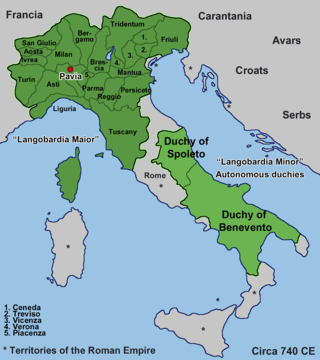
Langobardia Minor was the name that, in the Early Middle Ages, was given to the Lombard domains in central and southern Italy, corresponding to the duchies of Spoleto and Benevento. After the conquest of the Lombard kingdom by Charlemagne in 774, it remained under Lombard control.

Ansa or Ansia was a Queen of the Lombards by marriage to Desiderius (756–774), King of the Lombards.

The Kingdom of the Lombards, also known as the Lombard Kingdom and later as the Kingdom of all Italy, was an early medieval state established by the Lombards, a Germanic people, on the Italian Peninsula in the latter part of the 6th century. The king was traditionally elected by the very highest-ranking aristocrats, the dukes, as several attempts to establish a hereditary dynasty failed. The kingdom was subdivided into a varying number of duchies, ruled by semi-autonomous dukes, which were in turn subdivided into gastaldates at the municipal level. The capital of the kingdom and the center of its political life was Pavia in the modern northern Italian region of Lombardy.

The Duchy of Friuli was a Lombard duchy in present-day Friuli, the first to be established after the conquest of the Italian peninsula in 568. It was one of the largest domains in Langobardia Major and an important buffer between the Lombard kingdom and the Slavs, Avars, and the Byzantine Empire. The original chief city in the province was Roman Aquileia, but the Lombard capital of Friuli was Forum Julii, modern Cividale.
Ferdulf or Fardulf, originally from the territories of Liguria, was the Duke of Friuli at some point between the end of the reign of Cunincpert (688-700) and the beginning of that of Aripert II (701-12). There is no evidence to associate his tenure to the year 705 alone or indeed to suggest that it was very brief.. Paul the Deacon described him as 'a man tricky and conceited' who had obtained the dukedom after the death of Duke Ado.
The Gausi or Gausian dynasty was a prominent Lombard ruling clan in the second half of the 6th century (547–572). They were either pagans or perhaps Arian Christians and were frequently at odds with the Roman Catholic Church. Under their rule, the Lombards first migrated into the Italian peninsula.

The Duchy of Tuscia, initially known as the Duchy of Lucca, was a Lombard duchy in Central Italy, which included much of today's Tuscany. After the occupation of the territories belonging to the Byzantines, the Lombards founded this flourishing duchy which, among other centres, also included Florence. The capital of the duchy was Lucca, which was located along the Via Francigena, being also the city where the duke resided.

Langobardia Major was the name that, in the Early Middle Ages, was given to the domains of the Lombard Kingdom in Northern Italy. It comprised Lombardy proper with its capital Pavia, the Duchies of Friuli and Trent as well as the Tuscany region. In the south, it was bordered by the Patrimonium Sancti Petri, which would become the Papal States following the 754 Donation of Pepin, stretching from the Tyrrhenian to the Adriatic Sea. The Lombard territories further to the south were called Langobardia Minor, consisting of the Duchies of Spoleto and Benevento.
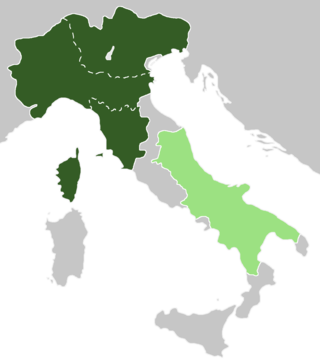
Neustria was, according to the early medieval geographical classification, the western portion of Langobardia Major, the north-central part of the Lombard Kingdom, extended from the Adda (river) to the Western Alps and opposite to Austria. The partition had not only been territorial, but also implied significant cultural and political differences.
Among the Lombards, the duke or dux was the man who acted as political and military commander of a set of "military families", irrespective of any territorial appropriation.
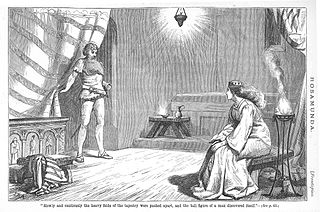
Helmichis was a Lombard noble who killed his king, Alboin, in 572 and unsuccessfully attempted to usurp his throne. Alboin's queen, Rosamund, supported or at least did not oppose Helmichis' plan to remove the king, and after the assassination Helmichis married her. The assassination was assisted by Peredeo, the king's chamber-guard, who in some sources becomes the material executer of the murder. Helmichis is first mentioned by the contemporary chronicler Marius of Avenches, but the most detailed account of his endeavours derives from Paul the Deacon's late 8th-century Historia Langobardorum.

The coinage of the Lombards refers to the autonomous productions of coins by the Lombards. It constitutes part of the coinage produced by Germanic peoples occupying the former territory of the Roman Empire during the Migration Period. All known Lombard coinage was produced after their settlement of Italy. The coinage originates from two distinct areas, in Langobardia Major between the last decades of the sixth century and 774, and in Langobardia Minor, in the duchy of Benevento, between approximately 680 and the end of the 9th century.

The Plutei of Theodota are two mid 8th-century Lombard marble bas-reliefs or plutei from the oratory of San Michele alla Pusterla in Italy. They are now held in the Civic Museums of Pavia. Naturalistic in style, they were produced during the Liutprandean Renaissance. One shows the Tree of Life between two griffins and the other shows a cross and font between two peacocks.
Theodota was a Byzantine noblewoman, most notable for her association with the Lombard king Cunipert (688-700). The Plutei of Theodota are named after her.









